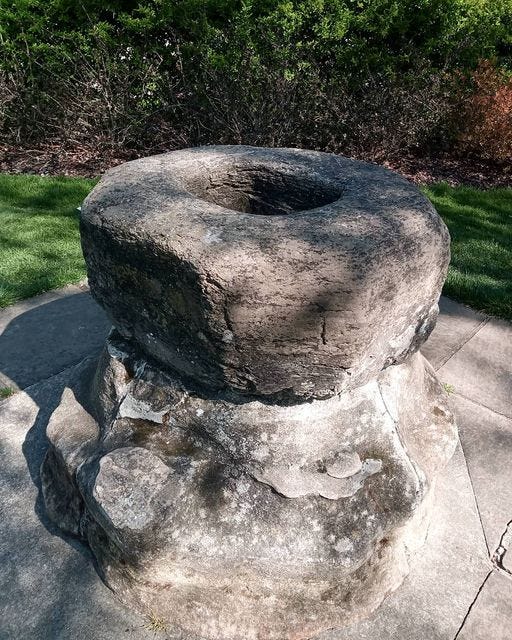
You might not believe this but the vinegary pickles, chutneys, and sauces we serve at celebratory feasts are gastric peacemakers. Possessed of a contradictory ability to act as an agonist or antagonist, vinegar is the bicep muscle of the food world. It can transform an already robust onion into a sturdier pickled version of itself or tenderise meat and fish; its presence in a dish can be harmonious and subtle or a sharp screech; it can emulsify or separate, disinfect and heal or inflame and damage. Used judiciously, it can extend the life of some ingredients or destroy others in minutes. It can take years to make and be a symbol of wealth and taste or produced swiftly in huge quantities relatively cheaply to preserve and flavour foods traditionally considered inexpensive. “If I had the choice between smoked and tinned salmon, I'd have it tinned. With vinegar,” claimed Harold Wilson in an attempt to win over the working class. (Tinned salmon with a dash of malt vinegar and white pepper was a treat at my grandparents. (It felt fancy and remains so because have you seen the price of canned red salmon these days?)
I used to swig malt vinegar straight from the bottle, only stopping when my father died from cancer of the stomach in 2012. Back then, the family malt vinegar of choice was Sarsons, which continues to earn a place on my kitchen shelves, but as you’d expect, it now has company -and a lot of it. Non-Brewed Condiment, that staple of the chippy (and my grandparent’s glove compartment for evenings spent eating fish and chips in the car at one beauty spot or another is always close by (Gen Z and Millenials have now made its acquaintance), as is Cornish malt from the Artisan Vinegar Company (which I wrote about for OFM). I won’t bore you by listing the many other varieties and brands in my collection, but urge you instead to browse the list of vinegar-related writing from experts on the subject.
More on the Three Vinegar Tasters whose image heads up this post.
The base of Heyecross, aka The Plague Stone on Out Risbygate, is barely 200 yards from my house. Possibly dating back to a later outbreak of plague in 1677, its socket hole was filled with vinegar, allowing locals to disinfect their coins before walking to the market half a mile away. I think of it as The Vinegar Bowl. Nearby is St Peters’ Pit, an open-cast chalk mine once used for burying pneumonic Plague victims that is now grassed over and surrounded by trees and scrub.
I felt drawn to the Plague Stone during lockdown and walked there often. Its bowl was empty, and unless it had rained, dry. Filling it with malt vinegar and old coins was tempting, but I resisted. Nobody was about, which felt incongruent in what was one of the busiest parts of the town with a high concentration of young people. (Two schools, a college and a university, are located within 400 yards of the stone. Hundreds more children cycle or walk past as they travel to other schools, further away.) It was quiet for a long time.
Today, students gather around the Plague Stone again, chattering, eating and awaiting buses. Their company has softened its stark, admonitory presence, and the stone’s hollow is once again a receptacle for cigarette butts and candy wrappers. Once upon a time, this detritus might have seemed insouciant and disrespectful, but the return of children to school as the pandemic eased has suffused their messy littering with poignancy.
'Four Thieves Vinegar' was believed to protect against infection with the plague: ‘Take three pints of strong wine vinegar, add a handful each of wormwood, meadowsweet, wild marjoram, and sage, fifty cloves, two ounces of campanula root, two ounces of angelica, rosemary, and horehound, and three large measures of camphor. Place the mixture in a container for fifteen days, strain and express then bottle. Use it by rubbing on the hands, ears, and temples occasionally when approaching a plague victim,’ says the original recipe.
Acid Trip: Travels in the World of Vinegar by Michael Harland Turkell
Travelling through the USA, France, Austria, and Japan, Turkell takes his readers on an absorbing journey through the world of vinegar, an ingredient that many people take for granted but one which has as its ‘mother’ a complex interweaving of history, terroir, craft, and science. For those of you whose tastebuds are piqued, Turkell has thoughtfully included recipes from many leading chefs, including a delightful honey za’atar vinaigrette and an autumnal brown butter balsamic mushroom dish with hazelnut and sage.
Harland Turkell also wrote this piece for Food52.
The Vinegar Cupboard by Angela Clutton
Like I said, I used to drink vinegar. It’s unsurprising then that I read Angela's book in one greedy gulp. Winner of the Jane Grigson Trust Award, The Vinegar Cupboard shows us the versatility of vinegar as both an ingredient in the cooking process and as a finisher, contributing to the overall balance of a dish. Vinegar flavour and matching wheels, notes on tasting and storing, and guides to the categories of vinegar (fruits, balsamic, sherry, wine, cider, grain, malt, extracted and infused) are matched with excellent recipes designed to showcase each variety. These recipes reflect the vinegar world map at the start of her book, and there's not one I don't want to cook. Roasting tin gravy made with the vinegar of your choice, Sunday cockles with vermouth vinegar (from Catalunya), parched peas with bacon, lemongrass and rocket (using good old malt vinegar!), and a gorgeous elderberry pontac sauce from the eighteenth century for sausages, game or even langoustines all caught my eye though. This is more than a cookbook; it is a kitchen manual that will last a lifetime and beyond.
The Old Woman Who Lived in a Vinegar Bottle by Rumer Godden and Mairi Hedderwick
This traditional Scottish tale for children is not vinegar-related per se, but I am charmed by the thought of a house made from a vinegar bottle.
A while ago, I interviewed James Read about his new book. Called Of Cabbages & Kimchi, it covers all aspects of fermenting in a genuinely original and beguiling manner. Vinegar features a lot.
I adore Sour by Mark Diacono with its paper-cut sharp cover, parotid gland-pleasing recipes, and writing.
also has a substack.Dr Jessica B Harris’s recipe for Spicy Vinegar.
Nothing says I hate you like a Vinegar Valentine, by Becky Little in The Smithsonian.
You’ll find all manner of health claims made about apple cider vinegar, the latest in a long line of foodstuffs afforded miraculous properties well beyond their actual (evidence-based) health benefits. Netflix is to make a series based on scammers and grifters in the food and wellness world. Find details here.
Nigella’s fantastic recipe for salt and vinegar potatoes made with apple cider vinegar.
On making Diana Kennedy’s recipe for Mexican pineapple vinegar. I think of lime as the vinegar of Mexico.
Kylee Newton’s Turmeric Pickled Cauliflower.
Dan Lepard on vinegar cakes.
On Modena and its iconic Balsamic vinegar, via NY Times digitized archive.
The fascinating history of Goa’s toddy vinegar in Goya Journal.
This stunning Japanese brown barley vinegar would make a lovely gift. (I received no inducements, gifts, or payment to mention this product.) I love this ghostly bottle from Baron.
Mitch Tonks on his secret ingredient. Yes, it is a type of vinegar.
From What Katy Did by Susan Coolidge:
‘The "something delicious" proved to be weak vinegar and water. It was quite warm, but somehow, drunk up there in the loft, and out of a bottle, it tasted very nice. Besides, they didn't call it vinegar-and-water – of course not! Each child gave his or her swallow a different name, as if the bottle were like Signor Blitz's and could pour out a dozen things at once. Clover called her share "Raspberry Shrub," Dorry christened his "Ginger Pop," while Cecy, who was romantic, took her three sips under the name "Hydomel," which she explained was something nice, made, she believed, of beeswax.’ Child-me was captivated by the idea of vinegar and water, which is, in fact, a drink known as a ‘shrub’. Links to books mentioned in this newsletter are affiliated to Bookshop.Org. I receive a small commission should you click and buy. Find my bookshop here.






I think the first time I had shrub was at a talk by Angela Clutton at the Abergavenny food festival. More recently in Taiwan I discovered that drinking vinegar is very very popular and I absolutely loved it. It's sour but also balanced by sweet. Drank loads of it. Wish we could buy it as easily here! In Taiwan it was sold by most convenience stores.
What a brilliant newsletter, thank you. I love Acid Trip and Angela's book especially - and thank you for the mention. I'd very much like to visit the Plague Stone. I'll give you warning to get the kettle on if I do. Merry Christmas x